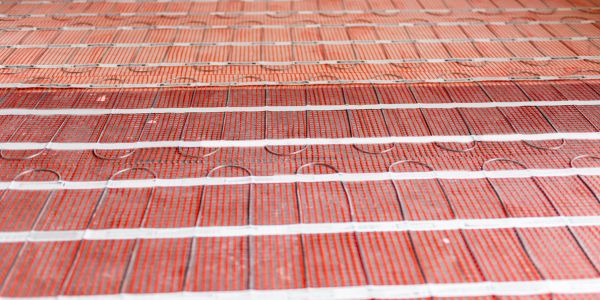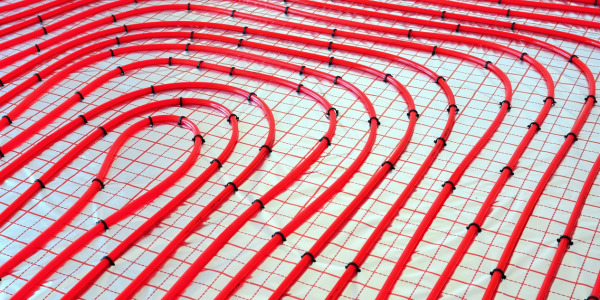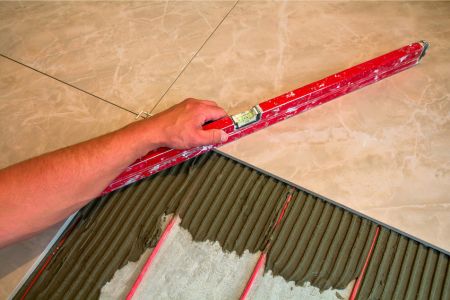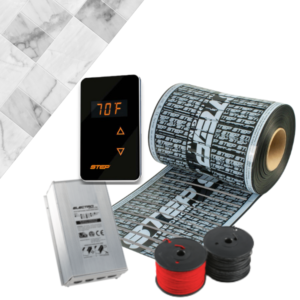Ensure it’s clean, dry, and level.
Discover the future of flooring luxury with our exquisite heated tile & stone floors


With decades of hands-on experience, we've honed our craft to become leaders in the heated floor industry. Trust in our expertise to deliver solutions that truly stand the test of time.

For our heated floors, we carefully select and offer only the best products. With GWD you're investing in durability, efficiency, and cutting-edge technology.

We're committed to providing top-tier heated floor solutions at prices that are competitive and fair. No compromises, just the best value for our valued clients.

Our team of highly skilled installers ensures that your heated floor system is set up seamlessly, with precision and care. Experience excellence from the ground up with our expert installation crew.
Delving into the world of radiant underfloor heating, there are two primary contenders: electric and hydronic systems. Both come with their unique set of benefits and challenges, ranging from installation complexities to maintenance needs.

Electric Radiant Underfloor Heating systems utilize electric resistance cables or mats to produce heat.The electric cables or mats are spread out and fixed across the floor, and once activated, they directly heat the floor surface above. Electric systems are inherently more reliable than hydronic systems as they have no mechanical or moving parts that could break down. The installation process is also much quicker and simpler, and there is no required maintenance.

Hydronic systems use a series of tubes laid beneath the floor into which warm water from a boiler circulates, producing radiant heat. They are typically more complex and expensive to install compared to electric systems and have a much higher likelihood of breaking down and need of repair. Hydronic systems also require regular maintenance unlike their electric counterparts.
Tile and stone flooring bring durability and elegance. With a range of materials from ceramic to granite, knowing the costs is key.
Below, we outline the primary expenses for these popular flooring choices.
| Tiles or Stone Flooring | $6-20/ft² |
|---|---|
| Plus | |
| System Cost | $14/ft² |
| Plus | |
| Installation Cost | $8-20/ft² |
| Plus | |
| Subflooring Replacement Costs | $3-10/ft² |
| Plus | |
| Underlayment Costs | $0.50-4.50/ft² |
| Total | |
| Low End Estimate | $29.50/ft² |
| Upper End Estimate | $84.50/ft² |
Same as New Build
Plus
Removal of Old Flooring = $1.50-3.50/ft²
Same as New Build
* Retrofitting entails placing the heating component between the floor joists from underneath the room. This method doesn’t necessitate changing the completed floor; however, it does demand access from an open ceiling below the room. If there’s an existing finished ceiling, like drywall or plaster, it will have to be taken down to access the joists.
Heated tile and stone floors provide lasting warmth with a touch of elegance. To ensure their full potential is realized, precision in installation is key.
From initial subfloor preparations to final system verifications, here are the fundamental steps for a successful setup.
Ensure it’s clean, dry, and level.
Decide on the layout and spacing.
Prevent heat loss and direct warmth upwards.
Follow the planned layout.
Ensure a safe electrical connection.
Adhering to manufacturer’s guidelines.
Re-test the system post-installation.
Yes, it’s absolutely possible. Whether you’re renovating an existing space or constructing a new one, underfloor heating is an excellent addition to Tile & Stone floors, enhancing both their comfort and luxury appeal.




EXCELLENTTrustindex verifies that the original source of the review is Google. Sorted our yoga studio heating with some radiant heaters from Green wave. They are an excellent company, who seem to have the client/customer at the centre of what they do!Trustindex verifies that the original source of the review is Google. They helped our designer with the CAD designs for our underfloor heating and spent time with out contracted heating engineer explaining how to install everything. Since the new build the whole heating system seems to be working perfectly and is very energy efficent! Would highly recommend to anyone looking to get underfloor heating.Trustindex verifies that the original source of the review is Google. "I recently had the pleasure of installing GWD's Radiant Heating system under my tile floor in the bathroom, and I must say that it has been an absolute game-changer. Not only has it made the floor warm and cozy to the touch, but it has also made the entire bathroom feel more comfortable during colder months. One of the things I appreciated most about GWD's system was how easy it was to install. The instructions were straightforward, and the whole process took only a few hours. Since the installation, the system has been running smoothly and efficiently without any issues. Overall, I'm extremely pleased with the Radiant Heating system, and I would highly recommend it to anyone looking for a comfortable and efficient heating solution for their floors. "Trustindex verifies that the original source of the review is Google. Our radiant heat mats from green wave distribution have massively brought down the cost to heat our home and have worked perfectly since being installed!Trustindex verifies that the original source of the review is Google. They spent time with our hired heating engineer explaining how to install everything and assisted our designer with the CAD plans for our underfloor heating. The entire heating system seems to be operating flawlessly and efficiently ever since the new construction! I would strongly recommend underfloor heating to anyone.Trustindex verifies that the original source of the review is Google. Managed to get our heated driveway sorted using GWD's. They did a fantastic job expliaining how it all works and working alongside our contruction contractors to get the mats installed. Would 100% recommend!Trustindex verifies that the original source of the review is Google. Really great company! Having a company like Green wave distribution to help us make the right decisions and install the radiant floor heating correctly was a god send. They had everything we needed and did a fantastic job :)Trustindex verifies that the original source of the review is Google. Ordered some snow melt mats from Green wave distribution. They are doing a great job! Big shoutout to Drew who helped with advising the type and explained all the technicalities!Trustindex verifies that the original source of the review is Google. The heat mats were easy to install and the team at Green wave distribution were on hand to help out with any issues or questions we had. If you are looking for underfloor heating, I would highly recommend giving these guys a call!Trustindex verifies that the original source of the review is Google. Green wave helped our designer with the CAD designs for our underfloor heating and spent time with out contracted heating engineer explaining how to install everything. great service,highly recommended.
Heated tile floors offer several benefits that can make them worth the investment for many homeowners. They provide consistent warmth, making tile surfaces comfortable to walk on, especially during colder months. This can enhance the overall comfort of a room or space, particularly in bathrooms or kitchens where tiles are commonly used. Additionally, radiant floor heating can be more energy-efficient than traditional heating methods as it heats from the ground up, ensuring even heat distribution with minimal heat loss.
The cost to run heated tile floors depends on several factors, including the size of the area being heated, the duration of use, the local cost of electricity, and the system’s efficiency. Electric under-tile heating systems, on average, consume between 8 to 15 watts per square foot. For example, a 100-square-foot bathroom might use between 800 to 1,500 watts when the system is on. When compared to traditional heating methods, radiant floor heating can be more cost-effective in terms of energy usage because of its efficient heat distribution.
No. Another major benefit of radiant heat mats comes from their energy efficiency. An independent study has validated that our heat mat material properties are designed to use 2X less output when compared to hot water radiant tube systems and 2.5X less output when compared to line voltage-powered cable and mat radiant systems. A consumption analysis comparison can be undertaken for your specific application.
Heated stone floors and heated tile floors are both efficient conductors of heat due to their dense nature. However, stone typically has a higher thermal mass than tile, allowing it to retain and radiate heat for longer periods. This can make stone slightly more efficient in terms of energy retention. However, the actual efficiency can also depend on the specific type of stone or tile, the thickness, and the heating system used. In general terms, both materials work well with underfloor heating, offering good heat distribution and comfort.
The only other additional cost you are likely to encounter when installing radiant heated floor systems is for floor insulation. This can be required for retrofits, remodels or new build projects but only in certain scenarios, such as rooms that are located above an unheated room or rooms that are on concrete slabs.